- Faculty News
- Student News
- Lab News
- Publications
- Meetings and Presentations
- Outreach
- Grants
- Announcements
- About This Newsletter
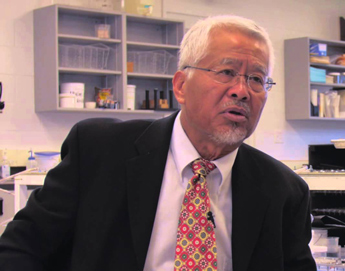
ABOVE: Dr. Nan-Yao Su was selected as one of two 2017 UF Foundation Term Professorship Awards in support of the university’s preeminence goals and to support faculty research efforts.
Paul and Lois, we appreciate your 75 years of combined service!
Paul Ruppert retires this month after nearly 40 years of employment with the department in Gainesville. Paul’s relationship actually extends back a bit further, as he worked with Citrus County Cooperative Extension, and then the Vegetable Crops Department, before moving to Entomology & Nematology. Paul devoted most of his career to Extension-related activities, and was affiliated with faculty such as Dr. Freddie Johnson (veg and field crop entomology), Dr. Don Short (turf and ornamental entomology), Dr. Susan Webb (vegetable entomology), and Dr. Eileen Buss (turf and ornamental entomology).
For several years Paul coordinated the department’s diagnostic activities in support of county staff and the general public. Along the way he also found time to become a certified arborist and certified to teach in youth agricultural programs. More recently he assumed department-wide support activities, thereby coordinating renovation, maintenance and repair of Steinmetz Hall, its support structures, and landscaping. He will be missed by the department, but welcomed at home by his wife Kathleen, who preceded him in retirement and who has been working on a long list of projects for him to do so he doesn’t get bored in retirement.
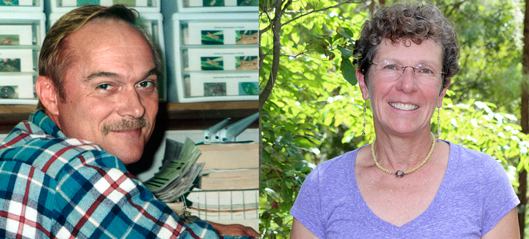
ABOVE: Our August retirees Paul Ruppert (left) and Lois Wood (right) have a combined 75 years of service to our department. Their contributions cannot be expressed in a few sentences, but we have given you a snapshot here of their time with us.
On August 31, 2017, Lois Wood, will be retiring after 35 years of service with our department. Lois received her M.S. with Walter Tschinkel at Florida State University in 1979 and then spent three years conducting studies for the state of Florida on salt marsh-inhabiting sparrows and several endangered species. Lois joined our department and began working with Dr. Jerry Stimac’s laboratory in September 1982 where she assisted with his insect pathology program that focused on Beauveria bassiana. While working with Jerry, Lois had the enviable opportunity to work in Brazil where she spent 6+ months on a fire ant project.
From 2003 until early 2005, Lois worked with Dr. Eileen Buss in the landscape entomology program. Thereafter, Lois joined the veterinary entomology program with Dr. Phil Kaufman where she coordinated studies on an array of fly and tick pests, dung beetles, and insecticide evaluations as well as tracking the myriad of regulatory requirements, graduate student needs and supervision of the program staff. Lois’ daily presence will be missed, but we know she looks forward to enjoying her free time to engage in volunteer efforts and spend more time with her horse, Shoshone, and less time on Archer Rd at 7:45 am. If you have a chance, stop by room 3237 and wish her well before the end of the month. Thank you Lois for your exceptional commitment to UF and the department!
 Dr. Peter DiGennaro has been accepted as a faculty member of the University of Florida Genetics Institute.
Dr. Peter DiGennaro has been accepted as a faculty member of the University of Florida Genetics Institute.
 Dr. Peter DiGennaro and Dr. Jennifer Gillett-Kaufman served as UF/CALS Florida Youth Institute expert panelists to help choose the Florida representatives to the Global Youth Institute sponsored by the Word Food Prize Organization.
Dr. Peter DiGennaro and Dr. Jennifer Gillett-Kaufman served as UF/CALS Florida Youth Institute expert panelists to help choose the Florida representatives to the Global Youth Institute sponsored by the Word Food Prize Organization.
 Dr. Mei-Ying Lin, from the Chinese Academy of Sciences has just started a 12 month sabbatical with the Branham Lab where she will be continuing her research on the systematics and taxonomy of the beetle family Cerambycidae. Stop by and introduce yourself to Dr. Lin!
Dr. Mei-Ying Lin, from the Chinese Academy of Sciences has just started a 12 month sabbatical with the Branham Lab where she will be continuing her research on the systematics and taxonomy of the beetle family Cerambycidae. Stop by and introduce yourself to Dr. Lin!
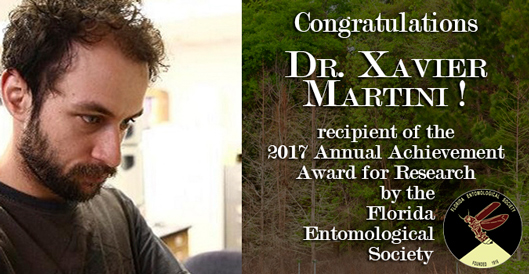
ABOVE: Dr. Xavier Martini (North Florida Research and Education Center) was awarded the 2017 Annual Achievement Award for Research by the Florida Entomological Society at the last meeting of the society in Puerto Rico on July 19th.
 Ms. Adriana Mitchell, a former biological researcher for Dr. Emma N.I. Weeks and Dr. James P. Cuda, won the non-student poster competition at the 57th Annual Meeting of the Aquatic Plant Management Society held at Daytona Beach, 16-19 July. Adriana received $100 for her poster titled “Impact of food deprivation on hydrilla tip-mining midge survival and subsequent development.” The poster was co-authored by Alissa Berro, Dr. Cuda, and Dr. Weeks. Adriana has since moved on from the laboratory to a position as an executive secretary for Senator Keith Perry.
Ms. Adriana Mitchell, a former biological researcher for Dr. Emma N.I. Weeks and Dr. James P. Cuda, won the non-student poster competition at the 57th Annual Meeting of the Aquatic Plant Management Society held at Daytona Beach, 16-19 July. Adriana received $100 for her poster titled “Impact of food deprivation on hydrilla tip-mining midge survival and subsequent development.” The poster was co-authored by Alissa Berro, Dr. Cuda, and Dr. Weeks. Adriana has since moved on from the laboratory to a position as an executive secretary for Senator Keith Perry.
The Entomology and Nematology Department is proud to announce that we have several summer graduates!
Ph.D. degrees: Dr. Pablo Allen, Dr. Dawn Calibeo, Dr. Lucas Carnohan, Dr. Maria Carrasquilla, and Dr. Silvia Vau.
M.S. degrees: Anthony Abbate, Dallin Ashby, Anil Baniya, Heather Erskine, Michael Gonzalez, and Nicholas Tucker.
B.S. degrees: Liam Covey-Shannon, and WinDi Sanchez.
We wish our graduates much success!
 Jeremiah Foley defended his Master of Science, with Dr. Nan-Yao Su and Dr. Robin Giblin-Davis in May. He studied termite-nematode associations. He is now moving on to do his Ph.D. at Virginia Tech.
Jeremiah Foley defended his Master of Science, with Dr. Nan-Yao Su and Dr. Robin Giblin-Davis in May. He studied termite-nematode associations. He is now moving on to do his Ph.D. at Virginia Tech.
 Lucas Carnohan defended his Ph.D. with Dr. Nan-Yao Su in June. He studied the potential of Ecdysone-like compounds for termite control. He is now working for Innovative Pest Management in Washington, DC.
Lucas Carnohan defended his Ph.D. with Dr. Nan-Yao Su in June. He studied the potential of Ecdysone-like compounds for termite control. He is now working for Innovative Pest Management in Washington, DC.
 Congratulations to Entomology Club members Paige Carlson, Katherine Arguez, Becca Perry, Evan Waite, Sara Alvarez and Grace Cope who will all be receiving UF Entomology and Nematology Travel Scholarships to present their research at the Entomological Society of America meeting in Denver this November. Rebecca Perry and Grace Cope, will both give oral presentations about their independent research projects in the Dale Lab. Rebecca Perry is an Entomology major and the current president of the undergraduate Entomology Club. Grace Cope is a Visual Arts Studies major and minoring in Entomology.We are all proud of the work you do.
Congratulations to Entomology Club members Paige Carlson, Katherine Arguez, Becca Perry, Evan Waite, Sara Alvarez and Grace Cope who will all be receiving UF Entomology and Nematology Travel Scholarships to present their research at the Entomological Society of America meeting in Denver this November. Rebecca Perry and Grace Cope, will both give oral presentations about their independent research projects in the Dale Lab. Rebecca Perry is an Entomology major and the current president of the undergraduate Entomology Club. Grace Cope is a Visual Arts Studies major and minoring in Entomology.We are all proud of the work you do.
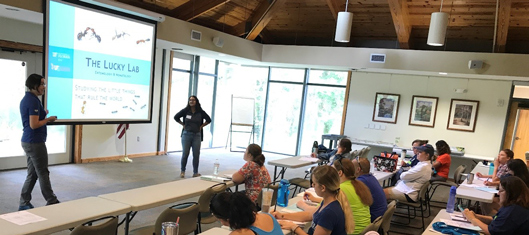
ABOVE: Lucky lab members Rachel Atchison (left) and Sara Alvarez (right) were asked to lead a presentation on how to incorporate citizen science into the classroom, featuring the Lucky Lab’s citizen science project the School of Ants. Their presentation was featured in a weeklong teacher training workshop for elementary school educators, held by UF/IFAS Pinellas County Extension at Brooker Creek Preserve in Tarpon Springs, FL.
 Chris Bibbs a Ph.D. student in Dr. Phil Kaufman’s lab, was interviewed for an article in Entomology Today on August 3rd, regarding a recent manuscript they published in the Journal of Integrated Pest Management. Bibbs research focus is on the use of pyrethroid spatial repellents against mosquitoes.
Chris Bibbs a Ph.D. student in Dr. Phil Kaufman’s lab, was interviewed for an article in Entomology Today on August 3rd, regarding a recent manuscript they published in the Journal of Integrated Pest Management. Bibbs research focus is on the use of pyrethroid spatial repellents against mosquitoes.
 The DiGennaro lab is excited to welcome Vincent Colantonio, a new Ph.D. student to the lab and Department this fall. Vincent is coming from Southern Illinois University where he completed his Masters degree in Molecular Biology, Microbiology and Biochemistry with a focus on Genetics, working on the etiology of soybean cyst nematode pathogenesis.
The DiGennaro lab is excited to welcome Vincent Colantonio, a new Ph.D. student to the lab and Department this fall. Vincent is coming from Southern Illinois University where he completed his Masters degree in Molecular Biology, Microbiology and Biochemistry with a focus on Genetics, working on the etiology of soybean cyst nematode pathogenesis.

We are pleased to recognize the student award winners from the 2017 Florida Entomological Society annual meeting:
Ph.D. student presentation winners: Cory Penca, Oliver Keller, and Simon Yeboah
M.S. student competition winners: Alicia Kelley, Morgan Pinkerton, and Anthony Abbate
Student travel grant awardees: Omotola Dosunmu, Oliver Keller, Marice Lopez, Octavio Menocal, Cory Penca, Babu Panthi, Christopher Bibbs, Morgan Pinkerton, Anthony Abbate, Zulaikha Mazlan, and Anthony Abbate
Need to name that bug? A host of experts are available to help Floridians identify any insect or related arthropod. If a mystery creature has six or more legs, the UF Insect ID Lab is the place to call.
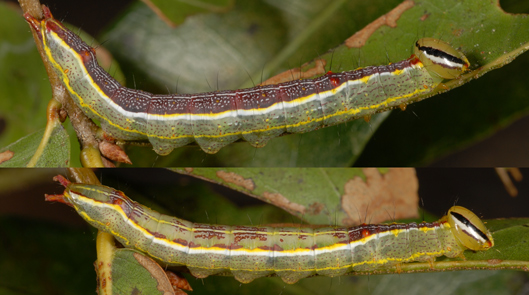
ABOVE: Several people in the Gainesville area have mentioned seeing variable oakleaf caterpillars feeding in their oak trees lately. The caterpillars feed high up in the canopy, so they often are not noticed until frass is raining down, defoliation is significant, or caterpillars are leaving the trees in order to pupate in the soil. As you would expect from their name, the caterpillars can be found with several different color patterns, a couple of which are shown here If you see large populations of these caterpillars or other insects, please let Lyle know. Knowing where outbreaks are occurring helps him handle public inquiries, and often provides nice photo opportunities!
Need insect images? You can go to this direct link, pictures are copyrighted material and intended for official UF use only, log onto the website using your Gatorlink credentials.
Lyle Buss is the UF/IFAS Insect ID Lab manager.
 Think it might be a nematode problem? The Nematode Assay Laboratory serves Florida and other states by providing nematode assays and expert advice regarding nematode management.
Think it might be a nematode problem? The Nematode Assay Laboratory serves Florida and other states by providing nematode assays and expert advice regarding nematode management.
For more information on the Nematode Assay Laboratory please contact the lab manager Dr. Tesfa Mengistu.
Aldridge RL, Kaufman PE, Bloomquist JR, Gezan SA, Linthicum KJ. 2017. Permethrin and malathion LD90 values for Culex quinquefasciatus vary with topical application site. Medical and Veterinary Entomology. 31: 306-311. Doi: 10.1111/mve.12236
Alto BW, Wiggins K, Eastmond B, Velez D, Lounibos LP, Lord CC. 2017. Transmission risk of two chikungunya lineages by invasive mosquito vectors from Florida and the Dominican Republic. PLoS Neglected Tropical Diseases 11(7): e0005724. https://doi.org/10.1371/journal.pntd.0005724
Media releases associated with publication.
PLOS Research News. How mosquitos interact with chikungunya virus depends on origin.
UF-IFAS Blogs. Can Florida mosquitoes transmit new strains of painful chikungunya virus?
Baidoo RS, McSorley R, Stamps RH, Brito JA, Crow WT. 2017. Management of root-knot nematode (Meloidogyne incognita) on Pittosporum tobira under greenhouse, field, and on-farm conditions in Florida. Journal of Nematology 49: 133-139.
Bernard S, Osbrink W, Su NY. 2017. Response of the Formosan subterranean termite to neighboring con-specific populations after baiting with noviflumuron. Journal of Economic Entomology 110: 575-583.
Bibbs CS, Kaufman PE. 2017. Volatile pyrethroids as a potential mosquito abatement tool: A review of pyrethroid containing spatial repellents. Journal of Integrated Pest Management 8: 21. Doi: 10.1093/jipm/pmx016.
Buss EA, Mannion C, Osborne L, Dale AG. Managing whiteflies on landscape ornamentals. UF/IFAS EDIS publication. Entomology & Nematology Department, University of Florida. EDIS# ENY-317.
Chouvenc T, Su NY. 2017. Testing the role of cuticular hydrocarbons on intercolonial agonism in two subterranean termite species (Coptotermes) and their hybrids. Insectes Sociaux 64: 347-355.
Chouvenc T, Scheffrahn RH, Mullins AJ, Su NY. 2017. Flight phenology of two Coptotermes species (Isoptera: Rhinotermitidae) in southeastern Florida. Journal of Economic Entomology 110: 1693-1704.
Crow WT. 2017. Nematodes - How do I know if I have a problem? USGA Green Section Record 55:1-6.
Crow WT, Becker JP, Baird JH. 2017. New golf course nematicides. Golf Course Management 85: 66-71.
Du H, Chouvenc T, Su NY. 2017. Development of age polyethism with colony maturity in Coptotermes formosanus (Isoptera: Rhinotermitidae). Environmental Entomology 46: 311-318.
Eiden AE, Kaufman PE, Oi FM, Dark M, Bloomquist J, Miller R. 2017. Determination of metabolic resistance mechanisms in pyrethroid-resistant and fipronil-tolerant brown dog ticks. Medical and Veterinary Entomology 31: 243-251. Doi: 10.1111/mve.12240.
Emberts Z, Miller CW, Li D, Hwang WS, St. Mary CM. 2017. Multiple male morphs in the leaf-footed bug Mictis longicornis (Hemiptera: Coreidae). Entomological Science 20: 396-401. doi: 10.1111/ens.12268.
Koi S. 2017. A butterfly picks its poison: Cycads (Cycadaceae), Integrated Pest Management and Eumaeus atala Poey (Lepidoptera: Lycaenidae). Entomology, Ornithology and Herpetology. doi: 10.4172/2161-0983.1000191
Koi S, Daniels JC. 2017. Life history variations and seasonal polyphenism in Eumaeus atala (Lepidoptera: Lycaenidae). Florida Entomologist 100: 1-11.
Larson JL, Dale AG, Held D, McGraw B, Richmond DS, Wickings K, Williamson RC. 2017. Optimizing pest management practices to conserve pollinators in turf landscapes: Current practices and future research needs. Journal of Integrated Pest Management 8: 1-10. doi: 10.1093/jipm/pmx012.
Stockton DG, Pescitelli LE, Martini X, Stelinski LL. 2017. Female mate preference in an invasive phytopathogen vector: How learning may influence mate choice and fecundity in Diaphorina citri. Entomologia Experimentalis et Applicata 164: 16-26.

New on Featured Creatures:
Habronattus jumping spiders, Habronattus (Pickard-Cambridge, 1901). Authors: Jeff Coco and Lisa Taylor, Entomology and Nematology Department, University of Florida.
A shoemaker butterfly, Prepona laertes (Hübner). Author: James E. Hayden, Taxonomic Entomologist, Florida Department of Agriculture and Consumer Services, Division of Plant Industry.
Redbanded stink bug, Piezodorus guildinii (Westwood). Authors: Morgan Pinkerton and Amanda Hodges, Entomology and Nematology Department, University of Florida.
Spiral nematode, Helicotylenchus pseudorobustus (major revision). Author: William T. Crow, Entomology and Nematology Department, University of Florida.
Do you have a favorite creature? Learn how to make it into a Featured Creatures!
The 50th Anniversary meeting of the Organization of Nematologists of Tropical America (ONTA) was held in Mayaguez Puerto Rico on July 10-14. UF Entomology and Nematology Department attendees included Dr. Billy Crow and Dr. Don Dickson (Gainesville), https://gcrec.ifas.ufl.edu/gcrec-facultystaff-directory/drjohandesaeger/ (GCREC), Dr. Larry Duncan (CREC), and grad students William Heve and Brandon Jones. At the meeting William Heve won second-place in the best student poster competition.
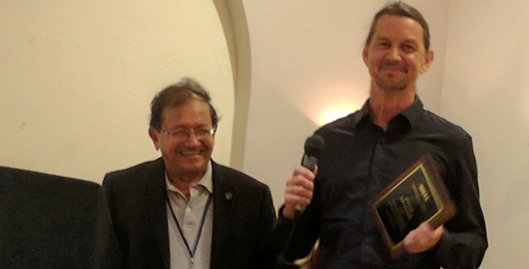
ABOVE: At the 50th Anniversary meeting of the Organization of Nematologists of Tropical America (ONTA) https://gcrec.ifas.ufl.edu/gcrec-facultystaff-directory/drjohandesaeger/ received a Special Recognition Award for his service to ONTA (Photo attached), as did one of our retired faculty, Dr. Jimmy Rich.
UF presentations at the 50th ONTA meeting:
Desaeger J, Noling JW, Inserra RN, Brito JA, Subbotin SA. Are invasive nematodes putting the squeeze on Florida strawberries?
Duncan LW, Renkema J, El-Borai F. Blueberry mulches modulate pest management and competition by microarthropods, fungi, and entomopathogenic nematodes in cadavers of insect larvae.
Crow WT. A new method for extraction of Meloidogyne spp. for diagnosis on golf greens.
Jones WB, Crow WT. Efficacy of incorporated organic amendments on turfgrass nematodes and turf health.
Heve WK, El-Borai F, Carrillo D, Duncan LW. Entomopathogenic nematode species richness is inversely related to Caribbean fruit fly integrated biological control in south Florida.
 Dr. Billy Crow and his grad student Benjamin Waldo presented research results at the West Florida Turfgrass Field Day in Jay on July 27th.
Dr. Billy Crow and his grad student Benjamin Waldo presented research results at the West Florida Turfgrass Field Day in Jay on July 27th.
 Dr. Adam Dale gave a webinar presentation for the Florida Master Gardener webinar series titled, "Update on landscape insect pest management in Florida" on July 27th.
Dr. Adam Dale gave a webinar presentation for the Florida Master Gardener webinar series titled, "Update on landscape insect pest management in Florida" on July 27th.
Dr. Adam Dale gave a presentation and field demonstration on July 13th at On Top of the World Communities and Candler Hills Golf Course where he talked to a group of residents about wildflower habitats on golf courses and the potential benefits associated with them.
Dr. Hugh Smith and Dr. Adam Dale hosted an In-service training (Joining forces to battle whiteflies in vegetables and ornamentals) for a group of county agents from throughout Florida on July 27th at the GCREC in Wimauma, FL. This training focused on whitefly identification and management on vegetable crops and ornamental plants.


ABOVE: At the end of July Dr. Silvana Paula-Moraes gave a presentation to farmers at the Corn Field Day, at the West Florida Research Education Center in Jay. The title of her presentation was: Corn Earworm and Fall Armyworm in Florida Panhandle: What We Need to Know. During the tour she showed pheromone traps around corn fields and explained how they can be used as a tool to survey species of Lepidoptera, such as corn earworm and fall armyworm. In her presentation, she discussed ecological aspects for the management of corn earworm and fall armyworm and the Bt technology available for their management. She is also presented the survey data she has been collecting in Florida Panhandle. With the help of her technician Latisa Letbetter-Kish, farmers and their children had a chance to learn how to identify and differentiate larva of corn earworm and fall armyworm.
 Dr. James P. Cuda was an invited speaker for the monthly Bivens Arm Neighborhood Association Meeting held in Gainesville on July 11th. Cuda gave a presentation on the hydrilla midge and the ongoing project to manage hydrilla in the Bivens Arm Lake. This project is being conducted in collaboration with the Alachua Co. Environmental Protection Department. One of the meeting attendees was Florida State Senator Keith Perry, who is very supportive of the project.
Dr. James P. Cuda was an invited speaker for the monthly Bivens Arm Neighborhood Association Meeting held in Gainesville on July 11th. Cuda gave a presentation on the hydrilla midge and the ongoing project to manage hydrilla in the Bivens Arm Lake. This project is being conducted in collaboration with the Alachua Co. Environmental Protection Department. One of the meeting attendees was Florida State Senator Keith Perry, who is very supportive of the project.
Dr. James P. Cuda was an invited speaker for the IFAS - Florida Turf Growers Association Great CEU Invasive Plant Control Roundup held via polycom on July 26th; over 300 attendees participated in the Roundup. Cuda gave a 50 minute presentation titled “Biological Control Update.”
 On July 26th, Dr. Xavier Martini delivered a presentation at the Citrus Grower’s Summer Update organized by UGA extension in Valdosta GA, on Asian citrus psyllid and citrus greening.
On July 26th, Dr. Xavier Martini delivered a presentation at the Citrus Grower’s Summer Update organized by UGA extension in Valdosta GA, on Asian citrus psyllid and citrus greening.
 Dr. Jacqueline Miller attended the 66th Annual Meeting of the Lepidopterists Society meetings at the University of Arizona, July 30th-August 1st, 2017. She presented a paper on the “Preliminary observations and biogeography of the Lepidoptera of the Bahamas.” During these meetings, she received the Willima D. Winter Service Award in recognition of lifelong contribution to the Society and its members. Following these meetings Dr. Miller also attended the Second North American Microlepidopterists’ Meetings at University of Arizona on August 2nd.
Dr. Jacqueline Miller attended the 66th Annual Meeting of the Lepidopterists Society meetings at the University of Arizona, July 30th-August 1st, 2017. She presented a paper on the “Preliminary observations and biogeography of the Lepidoptera of the Bahamas.” During these meetings, she received the Willima D. Winter Service Award in recognition of lifelong contribution to the Society and its members. Following these meetings Dr. Miller also attended the Second North American Microlepidopterists’ Meetings at University of Arizona on August 2nd.
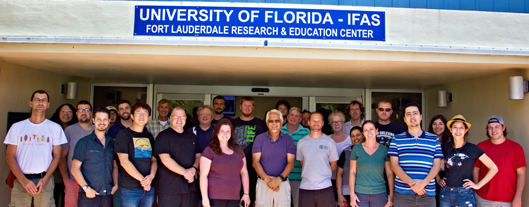
ABOVE: Dr. Rudolf Scheffrahn, Dr. Thomas Chouvenc, and Dr. Nan-Yao Su organized the biennial week-long termite class (ENY 4221 / ENY 6248) at the Ft. Lauderdale Research and Education Center in June 2017. This year saw a record number of participants (23), and Jan Šobotník (Czech University of Life Sciences, Prague) was a guest speaker for this class.
Dr. Thomas Chouvenc gave a research seminar at the Louisiana State University Department of Entomology on August 4th in Baton Rouge, LA. He highlighted the emerging issues in Florida concerning invasive subterranean termites, and how such issue is relevant to all southeastern states.
From the Outreach Coordinator
A big thank you to the students and faculty who volunteered for July’s outreach events!
- July 7th – Littlewood Elementary – Laurel Lietzenmayer
- July 11th – College Reach Out Program - Laurel Lietzenmayer
- July 18th – UF/CALS Florida Youth Institute – Dr. Rebecca Baldwin, Laurel Lietzenmayer, Eleanor Phillips
- July 20th – Ton-o-Fun Summer Camp – Laurel Lietzenmayer
- July 20th – Sumter and Hernando County Bug Camp – Dr. Rebecca Baldwin and Michael Gonzalez
- July 22nd – Zookeeper Day at Santa Fe Zoo – Sage Thompson and Brianna Whitman
- July 25th – Fear Facers Summer Camp, Laurel Lietzenmayer
- July 25th – Fort White Summer Camp – Michael Gonzalez
Upcoming Events
- August 12th – Girl Scout Troop
- August 16th – Boulware Springs Charter School
- August 20th – STEM is Elementary Showcase
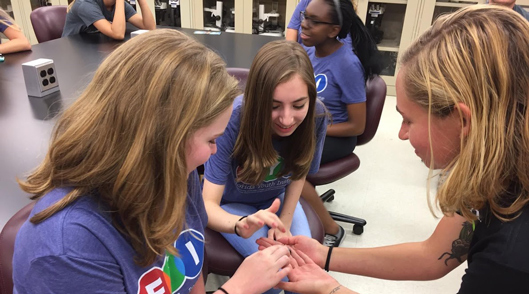
ABOVE: Graduate student, Eleanor Phillips (a member of the Gillett-Kaufman lab), shows off a Passalid beetle to students in the UF/CALS Florida Youth Institute.
The live critters are always a hit with children and adults alike. The critters are available for you to check out should you be leading an outreach event. We have doubles of our most popular critters, as well as various native insect species depending on the time of year. We have large wood and Plexiglas cages for viewing our native orb weaving spiders. There is one travel cage and one larger static cage. Please be sure to contact us and review the protocol on transporting and handling the critters if you are not already familiar with it. If you lead an outreach, be sure to fill out a documentation form so your event can be included in the newsletter and we can log all outreach events.
If you have any questions, please email me.
Thank you — Laurel Lietzenmayer, Outreach Coordinator.
If you would like to schedule an event or have any outreach questions, go to the Outreach pages on our Bug Club website and contact us. Getting social!
Dr. James P. Cuda was awarded a $1,500 travel grant from the FAES to attend the annual meeting of Hatch Multistate project “Biological Control of Arthropod Pests and Weeds.” The meeting will be held in Orlando, 4-7 March, 2018.
 The 2017 Crop Protection and Pest Management's (CPPM) Extension Implementation Program (EIP) application was recommended for funding. Funds will be shared by five subprojects: IPM Coordination for the University of Florida (N. Leppla), Housing and Residential Environments Housing (S. Preston, F. Oi, K. Stofer, B. Hughes), Plant Pest and Disease Diagnostic System (A. Hodges), IPM for Cotton Cultivars in North Florida (S. Viera de Paula Moraes), and Pollinator Plants and Pollinator Health (G. Knox).
The 2017 Crop Protection and Pest Management's (CPPM) Extension Implementation Program (EIP) application was recommended for funding. Funds will be shared by five subprojects: IPM Coordination for the University of Florida (N. Leppla), Housing and Residential Environments Housing (S. Preston, F. Oi, K. Stofer, B. Hughes), Plant Pest and Disease Diagnostic System (A. Hodges), IPM for Cotton Cultivars in North Florida (S. Viera de Paula Moraes), and Pollinator Plants and Pollinator Health (G. Knox).
Getting social!
We have several social media sites for the Entomology & Nematology Department. To make them easily searchable, all three (YouTube, Facebook and Twitter) have the same page name: UFEntomology. Please share these links with past students or colleagues who may have an interest in departmental activities.
![]() Want to stay up to date? Check out our website home page for a link to our Google calendar.
Want to stay up to date? Check out our website home page for a link to our Google calendar.
Dr. Jennifer Gillett-Kaufman is the newsletter editor and does the HTML coding. Issues usually are published by mid-month. Submit items for an issue by the seventh of that month.
We like to share news when it happens using our social media outlets: Twitter, Facebook and YouTube. Follow us on these sites for daily updates! When you send news, we will post it on one or more of these sites and again in the monthly newsletter. Please be sure you have permission from people in photographs you submit for publication.
UF-Bugnews-L listserv subscribers receive notices when issues are posted. Our home page has instructions for subscribing and unsubscribing.
Special thanks to Haleigh Ray and Nancy Sanders, who reviewed the newsletter for errors, and to Jane Medley and Don Wasik, who built the web page design.
Give Back
Want to support the UF Entomology & Nematology Department? Consider making an online gift today! Questions can be directed to Christy Chiarelli at (352) 392-1975 or ccw@ufl.edu.